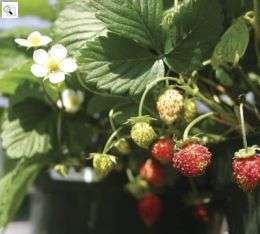Scientists hope to create robot strawberry pickers

Scientists at the National Physical Laboratory (NPL), the UK's Measurement Institute, have developed an imaging technology which can identify the ripeness of strawberries before they are picked. The developers now hope to work with the agricultural industry to turn it into fruit picking robots that will reduce food waste and improve productivity.
Successful trials have been completed on strawberries as well as a number of other crops. The software has also been designed to 'learn' based on past experience, so tests for new crops can be quickly developed.
The work began in 2009, as a project to identify the ripeness of cauliflowers, which were a problem for pickers due to their leafy exterior. The technology was completed and successfully demonstrated, but a drop off in demand for cauliflowers stalled the project. Having proved the concept, lead scientist Dr Richard Dudley, began developing the technology for a wider range of fruit and vegetables and is taking it to market.
Dudley said: "The focus now is strawberries. This is a fairly easy fruit to measure as it has high water content and dry leaves, and microwave imaging is particularly useful for identifying water levels. Strawberries are also a high value fruit which are very time-consuming to pick so there is a stronger business case to implement automated picking technology for strawberries than with some other crops."
Annual waste from picking unripe crops can be high and can mean many thousands of pounds of lost revenue for farms every year. As a result the agriculture industry is constantly on the lookout for more efficient ways of harvesting crops.
NPL's new technology uses radio frequencies, microwaves, terahertz and the far-infra red. These four parts of the electromagnetic spectrum all have potential to safely penetrate the crop layers and identify whether the crop meets the pre-designed criteria for ripeness, for a relatively low cost. NPL has developed this technology, and the requisite software, for crop identification and selection.
The researchers at NPL began by modifying microwave measurement systems to measure the structure of various crops. A series of measurements made on real crops in the laboratory and field enabled a statistical range of measurements for precise size and ripeness identification. This data was then designed into an algorithm which allows the technology to provide the relevant information from a single measurement.
Dudley adds: "The agriculture industry does not have access to equipment or the skills required to operate in these parts of the electromagnetic spectrum. But having effective ways of identifying ripeness is going to be important in improving efficiency and reducing waste. It is also a vital part of the move to automation, which is a big issue for the agricultural industry right now as it could dramatically improve global harvesting productivity and ultimately benefit consumers through cheaper food in supermarkets."
The imaging technology developed for this project is also finding other applications, notably in waste management, where it is being developed to sort waste, such as plastics, paper and wood, for effective burning for energy generation.
Provided by National Physical Laboratory
















